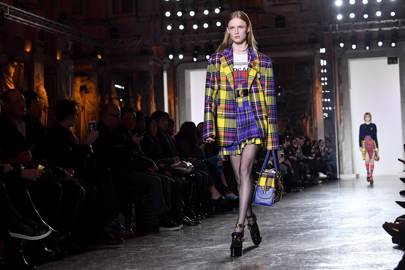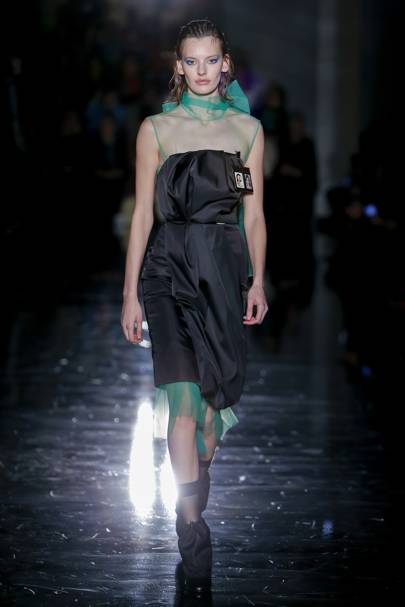“It’s the constant struggle between retaining femininity and being strong,” Prada said after her show, where pretty princess tulle dresses tied in big blooming bows behind the neck were armoured with voluminously draped strapless dresses or dense bustiers, fusing the fragile with the fierce. “The constant duality between what you have to be in order to be strong and able to protect yourself, and what we’ve inherited: the sweetness, the femininity.” At Fendi, Karl Lagerfeld and the Fendi matriarch embellished their menswear-informed 1980s working girl silhouette with handkerchief embroideries, retaining “a touch of how we were,” as Venturini Fendi put it, referring to women. “In our country, which is kind of patriarchal, we’ve always been considered an emblem for women,” she said, referring to her house historically run by her sisters and aunts. “They were using soft power,” she said, gradually breaking down a male-dominated industry. “It’s not a time to fight anymore, especially at Fendi.”
The working girl look also took centre stage at Alberta Ferretti and at Max Mara where Ian Griffiths got to live out a life-long dream: merging the punk he lived and wore in 1980s Manchester with Max Mara’s elegant but masculine tailoring. He was waiting for the right zeitgeist to back it up. “Max Mara power-dressing and the dress codes of the 1980s enabled women to get into the workplace,” Griffiths said. “Meanwhile, people like me, who were punks, adopted chains and studs as a complete sign of refusal to participate.” In his runway amalgamation of these values, Griffiths called full throttle on the fighting spirit but retained a decided sense of super-feminine sexy, which also felt very 1980s. Punk was on the agenda at Versace, too. Through her Italian looking glass, Donatella Versace-fied British heritage in tartan kilts, trench coats and football scarves, saluting the check-tastic appetite for heritage garments we’re seeing everywhere this season.

“Aristocracy today doesn’t come from birth. It’s who you are, not which family you were born into,” she said. You could transfer that whole view of humanity to the Gucci show where Alessandro Michele decked out his show space like an operating theatre and styled up a millennial fantasy storm of dragons, severed heads and snakes carried by models with third eyes stuck to their foreheads. “Nature has not given us an untouchable body,” Michele argued, talking about the relationship between “what we are and what we want to become.” What he meant was that you can transform yourself entirely by what you wear, and that in these revolutionising times you are the master of your own identity: simply pick who and what you want to be. If that’s a dragon tamer with three eyes, Godspeed to you. Michele’s woke-ness may have ruffled some religious feathers in the room, but fortunately there’s always Dolce & Gabbana to out-provoke everyone else.
Stefano Gabbana did say that the days of catholic Italy getting shocked by religious references in fashion are long gone. It paved the way for a tongue-in-cheek collection that celebrated all the trademarks of the Catholic Church where Gabbana still worships every Sunday. “We’re playing with our religion, but our religion is also fashion,” he said. Before the show they talked about their love of beauty, how beauty generates love and love creates more love. It’s these philosophies that materialise in the high-octane opulence that now defines Dolce & Gabbana, and which they genuinely believe will make the world a better place. “If you talk about all the bad things in the world, you kill the bellezza,” Domenico Dolce reflected. The doom and gloom that surrounds us in the news had made Lucie and Luke Meier imagine a more optimistic future in outer space for their second Jil Sander collection.
“We imagined going to space but taking a lot of things with you that make you feel comfortable. A very human touch,” Luke explained. The Meiers came at the idea of futurism with positivity, replacing our usual hard-edged technological view of the future with something homely and approachable. “Going to space in a cosy, comforting way,” Lucie offered. They interpreted the feeling in tactile softness: garments loosely based on space suits, which swathed and moved with the body. Using all natural fibres – no hi-tech stuff here – tops, skirts, and trousers were intricately knitted or woven to expand and contract with movement, an entirely futuristic look rooted in something hand-spun and human, characteristics also seen at Marni where a similar dystopian optimism (how’s that for an oxymoron) held court. At Moschino, Jeremy Scott had been thinking about life in space, too, albeit via unusual alleyways.

“The two conspiracy theories that have endured the longest are JFK’s assassination and Marilyn Monroe’s death,” he said, laying out his inspiration. “JFK told Marilyn Monroe about the fact that there are aliens. She was gonna come public with this information so they had her assassinated. And then he had to be assassinated for leaking the information, and… this whole thing about the aliens,” Scott elaborated. “Now here’s your leap forward: was Jackie actually an alien? Was she behind this whole thing? How could she be so stately and stoic if she was human? How could someone endure all that pain and still be perfect? Was she real? Is she an android?” he quipped, eyes wide open. Scott portrayed that idea in candy-coloured little skirt suits and above-the-knee coats with pillbox hats and wigs that spelled out Jackie O perfection, and models entirely covered in technicolour paint. “In my country, illegal aliens are a constant topic,” he reminded us, bringing his reference into current Trumpian affairs.
“So what is really an alien? Are they blue, yellow, green, purple, pink? Or are they just like you and I? What’s really different?” His sentiment was summed up on Saturday by Giorgio Armani himself, who proposed an ethnically eclectic collection, plucking characteristics from around the world. “We all live in the same sphere, and I don’t understand why one has to create the problems that are happening in the world,” he said. “This is a message to say we’re all on the same level.”





0 Yorumlar